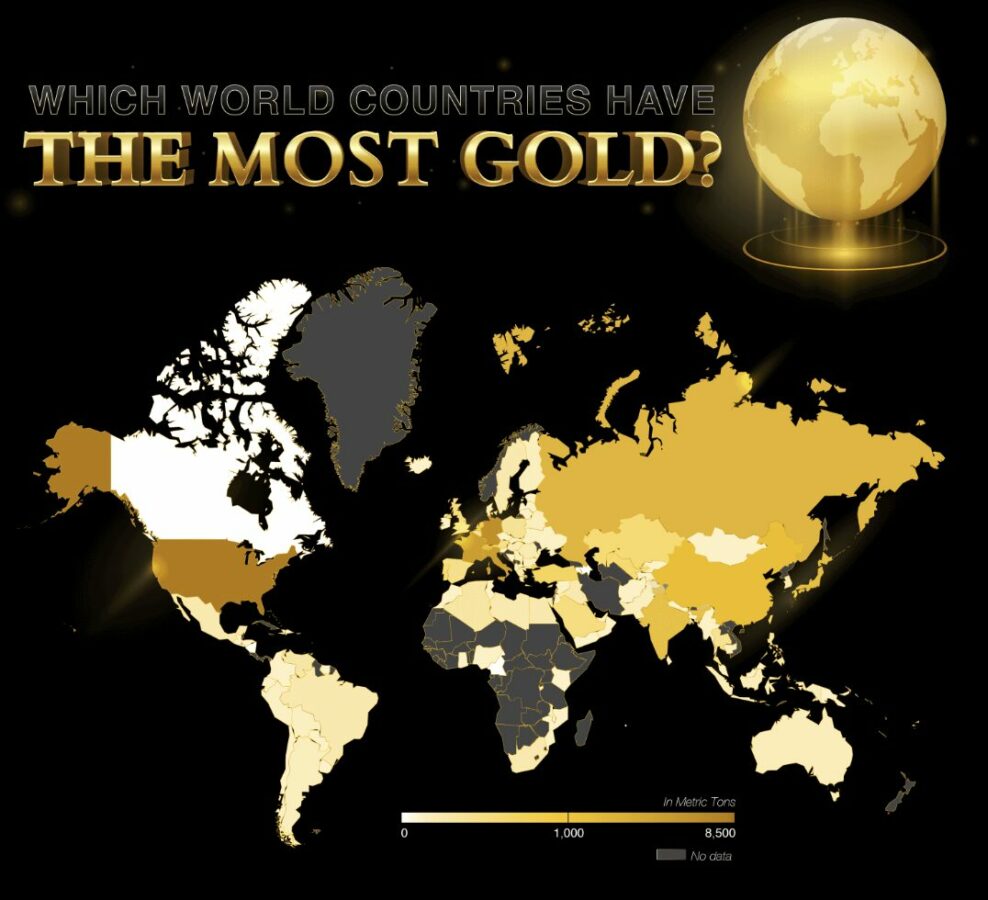As of early 2025, the global landscape of gold reserves has seen notable shifts, with central banks actively adjusting their holdings in response to economic uncertainties and geopolitical dynamics. Here’s an updated overview of the top 50 gold-holding countries, incorporating the most recent data available:
I have gold for sale in BANGKOK, DUBAI FREEZONE, HONG KONG & USA (MT)
🌍 Top 50 Countries by Gold Reserves (as of February 2025)
| Rank | Country | Gold Reserves (Metric Tons) | Estimated Value (USD) | Notes |
|---|---|---|---|---|
| 1 | 🇺🇸 United States | 8,133.5 | ~$865.84B | Largest holder; reserves unchanged. |
| 2 | 🇩🇪 Germany | 3,351.5 | ~$356.78B | Significant portion repatriated. |
| 3 | 🇮🇹 Italy | 2,451.8 | ~$260.95B | Maintains strong reserves within Eurozone. |
| 4 | 🇫🇷 France | 2,437.0 | ~$259.37B | Key Eurozone player with substantial holdings. |
| 5 | 🇷🇺 Russia | 2,332.7 | ~$248.63B | Increased reserves amid sanctions. |
| 6 | 🇨🇳 China | 2,279.6 | ~$242.66B | Resumed purchases after a pause. |
| 7 | 🇨🇭 Switzerland | 1,039.9 | ~$110.72B | Known for financial stability. |
| 8 | 🇮🇳 India | 876.1 | ~$93.24B | Second-largest buyer in 2024. |
| 9 | 🇯🇵 Japan | 845.9 | ~$90.03B | Holds reserves to support the yen. |
| 10 | 🇵🇱 Poland | 765.0 | ~$81.43B | Largest buyer in 2024. |
| 11 | 🇳🇱 Netherlands | 612.4 | ~$65.18B | Stable holdings within Eurozone. |
| 12 | 🇹🇷 Turkey | 595.4 | ~$63.40B | Active in managing reserves. |
| 13 | 🇹🇼 Taiwan | 422.4 | ~$44.92B | Supports economic resilience. |
| 14 | 🇵🇹 Portugal | 382.6 | ~$40.72B | Legacy of historical wealth. |
| 15 | 🇺🇿 Uzbekistan | 382.5 | ~$40.71B | Increased reserves in 2024. |
| 16 | 🇸🇦 Saudi Arabia | 355.4 | ~$37.85B | Complements oil wealth. |
| 17 | 🇰🇿 Kazakhstan | 323.1 | ~$34.38B | Returned to net buyer status. |
| 18 | 🇬🇧 United Kingdom | 310.2 | ~$33.02B | Supports global financial role. |
| 19 | 🇱🇧 Lebanon | 284.0 | ~$30.52B | Critical asset amid crises. |
| 20 | 🇪🇸 Spain | 281.6 | ~$29.97B | Aids Eurozone stability. |
| 21 | 🇦🇹 Austria | 279.9 | ~$29.80B | Buffer for open economy. |
| 22 | 🇹🇭 Thailand | 234.5 | ~$24.95B | Supports growing economy. |
| 23 | 🇧🇪 Belgium | 227.4 | ~$24.20B | Supports Eurozone role. |
| 24 | 🇸🇬 Singapore | 219.9 | ~$23.40B | Financial hub with strategic reserves. |
| 25 | 🇩🇿 Algeria | 173.6 | ~$18.47B | Supports oil-dependent economy. |
| 26 | 🇻🇪 Venezuela | 161.2 | ~$17.16B | Key asset amid economic collapse. |
| 27 | 🇵🇭 Philippines | 159.1 | ~$16.93B | Supports developing economy. |
| 28 | 🇱🇾 Libya | 146.7 | ~$15.61B | Vital asset amid instability. |
| 29 | 🇧🇷 Brazil | 129.6 | ~$13.80B | Aids large, diverse economy. |
| 30 | 🇪🇬 Egypt | 126.5 | ~$13.46B | Counters inflation and currency issues. |
| 31 | 🇿🇦 South Africa | 125.7 | ~$13.34B | Major gold producer. |
| 32 | 🇲🇽 Mexico | 125.4 | ~$13.31B | Supports trade-heavy economy. |
| 33 | 🇦🇺 Australia | 120.3 | ~$12.79B | Maintains modest reserves. |
| 34 | 🇦🇷 Argentina | 114.5 | ~$12.19B | Hedge against economic crises. |
| 35 | 🇮🇶 Iraq | 110.8 | ~$11.79B | Provides stability amid challenges. |
| 36 | 🇶🇦 Qatar | 110.0 | ~$11.71B | Supports wealth from natural gas. |
| 37 | 🇰🇷 South Korea | 104.4 | ~$11.12B | Complements tech-driven economy. |
| 38 | 🇷🇴 Romania | 103.6 | ~$11.03B | Hedge against economic volatility. |
| 39 | 🇰🇼 Kuwait | 79.8 | ~$8.49B | Complements oil wealth. |
| 40 | 🇮🇩 Indonesia | 79.0 | ~$8.41B | Supports resource-rich economy. |
| 41 | 🇦🇪 United Arab Emirates | 78.6 | ~$8.37B | Reflects financial hub status. |
| 42 | 🇯🇴 Jordan | 74.5 | ~$7.93B | Stability in a volatile region. |
| 43 | 🇵🇰 Pakistan | 71.6 | ~$7.62B | Aids economic stability. |
| 44 | 🇧🇾 Belarus | 66.5 | ~$7.08B | Supports economy amid sanctions. |
| 45 | 🇨🇿 Czech Republic | 64.7 | ~$6.89B | Aids stable economy. |
| 46 | 🇧🇩 Bangladesh | 61.7 | ~$6.57B | Supports growing economy. |
| 47 | 🇷🇸 Serbia | 53.8 | ~$5.73B | Aids economic stability. |
| 48 | 🇬🇭 Ghana | 51.1 | ~$5.44B | Increased reserves steadily. |
| 49 | 🇰🇬 Kyrgyzstan | 49.0 | ~$5.22B | Highest monthly net buying since Sept 2023. |
| 50 | 🇲🇦 Morocco | 48.2 | ~$5.13B | Supports developing economy. |
Note: Estimated values are calculated using the gold price of $3,311.33 per troy ounce as of April 30, 2025. One metric ton equals 32,150.75 troy ounces, so the value per ton is approximately $106,463,305.85.
Current Gold Price (USD per Ounce)
📈 Recent Trends and Notable Changes
-
Poland: Emerging as the largest buyer in 2024, Poland added 90 tonnes to its reserves, reaching a total of 765 tonnes. Rising Kashmir+1World Gold Council+1
-
India: With year-to-date purchases of 73 tonnes, India’s total gold reserves stood at 876 tonnes by the end of 2024, making it the second-largest buyer of the year. The Indian Express+3Rising Kashmir+3World Gold Council+3
-
China: After a six-month pause, the People’s Bank of China resumed gold purchases in November 2024, adding 5 tonnes and bringing total holdings to 2,264 tonnes. World Gold Council+1Rising Kashmir+1
-
Kazakhstan: Reversed its status to a net purchaser in 2024, with total reserves now at 295 tonnes. Rising Kashmir+1World Gold Council+1
-
Czech Republic: Extended its buying streak to 21 consecutive months, increasing its total holdings to just over 50 tonnes. Rising Kashmir
💡 Significance of Gold Reserves
Gold reserves play a pivotal role in a country’s financial strategy:
-
Economic Stability: Act as a hedge against inflation and currency fluctuations.
-
Diversification: Provide diversification of reserves, reducing reliance on other assets.Rising Kashmir
-
Geopolitical Security: Serve as a safeguard during geopolitical tensions and economic sanctions.
-
Confidence: Enhance confidence in a country’s monetary system.






 if you wish to Buy, Sell, Charter,Rent
if you wish to Buy, Sell, Charter,Rent